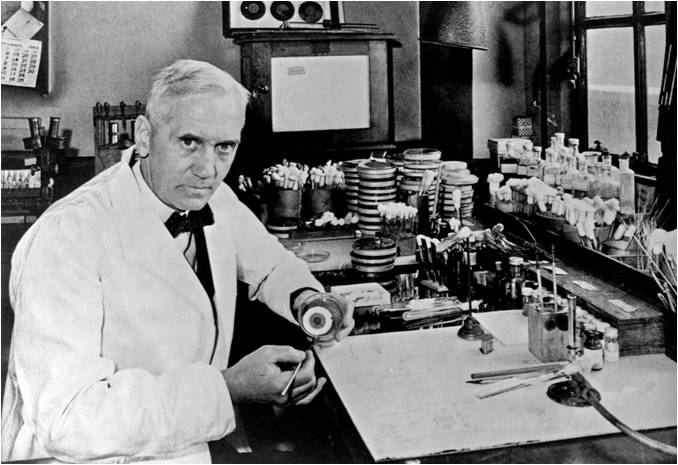Imagine it is the year 1899, and you have unfortunately contracted pneumonia. In most cases, that would be the end of your life due to the very few viable ways to treat bacterial infections before World War II. Many people lost their lives or suffered immensely due to disease in previous centuries. In modern times, we have penicillin, or one of its many variances, to cure most bacterial infections that we happen to contract over the course of our lives. The accidental and progressive invention of penicillin would be a revolutionary discovery that drastically changed the world and has saved countless lives since its 1928 discovery. It affected the average life expectancy and even completely changed how soldiers were affected on the warfront during the deadliest war of the 20th century, World War II.
Life Before Penicillin
The discovery of penicillin is arguably one of the greatest medical innovations of all time. Before penicillin, life expectancy was considerably shorter than today— a mere 47 years on average from birth. If one contracted any infection before the discovery of penicillin, then there was a considerably low chance of survival. One of the most common forms of medical therapy prior to the discovery of penicillin was bloodletting. It was used for over 3,000 years beginning with the Ancient Egyptians and was maintained as a common practice recommended by medical authorities up until the 1940s. For the treatment of syphilis prior to penicillin, mercury compounds were used to treat it and its side-effects, however, they would cause a variety of new side-effects that would cause long-lasting ailments to the body.
Alexander Fleming, the man behind the microscope
“When I woke up just after dawn on September 28, 1928, I certainly didn’t plan to revolutionize all medicine by discovering the world’s first antibiotic, or bacteria killer. But I guess that was exactly what I did.” — Alexander Fleming
Penicillin was discovered accidentally in London at St. Mary’s hospital in September 1928 by Alexander Fleming, a bacteriology professor. The professor returned to his laboratory after a vacation and discovered the moldy petri dishes containing a Staphylococcus bacteria which had been contaminated with a mold later identified as Penicilliumnotatum. Fleming discovered that this “mold juice” kills a variety of harmful bacteria. Fleming set the difficult task of isolating pure penicillin from the mold juice to his assistants, however it proved to be very unstable, and they were only able to prepare solutions of crude material to work with.He published his findings in the British Journal of Experimental Pathology and only briefly mentioned the therapeutic benefits of penicillin. There were continual attempts by other scientists to isolate the bacteria, but to no avail.

The USA and Mass Production of Penicillin
“You are urged to impress upon every worker in your plant that penicillin produced today will be saving the life of someone in a few days or curing the disease of someone now incapacitated. Put up slogans in your plant! Place notices in pay envelopes! Create an enthusiasm for the job down to the lowest worker in your plant.” — Albert Elder to Penicillin manufacturers
In order to successfully test the drug in clinical trials, the production time and efforts had to be substantially increased. Due to the dedication of most of the chemical industry in the war efforts, Florey and his team took their process to the United States to convince American pharmaceutical companies to produce penicillin on a large-scale. Florey’s contacts through Yale University allowed him to connect to the U.S. Department of Agriculture and secured a research and production home with the Department’s Northern Regional Research Laboratory (NRRL) in Illinois. The NRRL would prove to be a crucial factor later in the mass production of penicillin and its effects on the efforts in World War II.
The Production of Penicillin during WWII
“Too high a tribute cannot be paid to the enterprise and energy with which the American manufacturing firms tackled the large-scale production of the drug. Had it not been for their efforts there would certainly not have been sufficient penicillin by D-Day in Normandy in 1944 to treat all severe casualties, both British and American.” — Howard Florey, 1949
Subsequently in 1943, the War Production Board recognized the potential value of penicillin in war efforts and took considerable attempts to increase production of the drug. By the end of that year, the stock was sufficient to meet the demands of the Allied Armed Forces. Production of the antibiotic significantly increased from 1943 to 1945 from 21 billion units to more than 6.4 trillion units. As the production process was refined, the production scale increased and became more sophisticated as the demand for the antibiotic increased. By 1949, the annual production of penicillin in the United States was 133,229 billion units and the price of production and amount per unit dramatically decreased as its accessibility grew. The deep tank fermentation production of penicillin, pioneered in the United States, was also eventually adapted in the United Kingdom after the end of the war to continue to meet civilian demand, as well.
Penicillin Today and its Effects on the World
The unprecedented discovery of penicillin has completely changed the way humans live in modern times. After its discovery, life expectancy increased due to the reduction in the chance of dying from infections from injuries or STDs. Venereal diseases such as syphilis resulted commonly in life-changing symptoms, however, penicillin changed many lives of those affected. It was also beneficial in combating the bacterial infections that easily transferred person to person. It even changed the way people dressed. Gloves were a common accessory before the 1940s to cover the hands from any potential chance of getting sick. With the penicillin available to the masses to cure infections, there was less need to cover the hands to prevent getting sick.
Penicillin was merely the first in a variety of other antibacterial substances that would be discovered in subsequent years. Its innovation was a breakthrough in discovering other antibiotics that are commonly used today. However, these days a more pressing problem is affecting the penicillin’s influence over the human population: antibiotic resistance. As we use it to fight infections in our bodies, the bacteria will just learn how to combat the penicillin as the viruses continue to spread to other parts of the population. Will society have to go back to older methods of fighting infection and disease as more and more people display a biological resistance to the drug? Only time will tell.
By: Claire Seoyeon Kim
Write and Win: Participate in Creative writing Contest & International Essay Contest and win fabulous prizes.
















